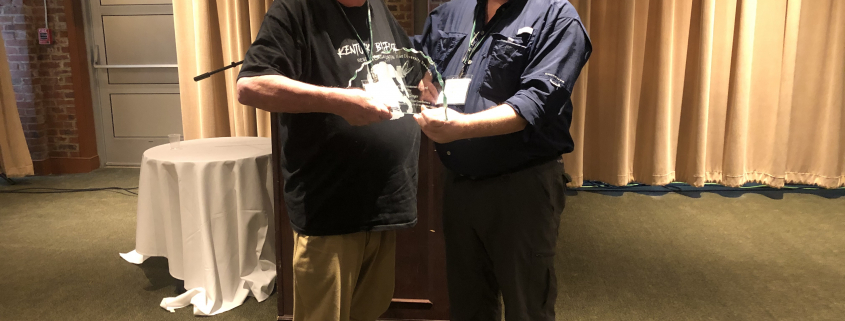
John MacGregor
SBDN Lifetime Achievement Award 2020
This year’s recipient has represented Kentucky Department of Fish and Wildlife Resources and U.S. Forest Service on the Indiana Bat Recovery Team. He has spent many tireless nights and much of his personal time reviewing draft versions of the Indiana Bat Recovery Plan and/or traveling to multi-agency meetings to discuss bat conservation and management. He has also volunteered countless hours preparing and giving oral presentations at government sponsored trainings, professional meetings (Such as SBDN, Kentucky Academy of Science, and North American Symposium on Bat Research, and at educational weekends like Herp and Wildflower Weekends). As David Saugey stated about this year’s recipient “he has spread the gospel of bats to thousands and thousands of people using his unique presentation style supported by truly remarkable photographs.” A trademark of his presentations is that they are always entertaining, visually stimulating, and educational. One such presentation entitled “The use of road ruts as water sources by bats in eastern Kentucky,” contained a photograph that took many attempts and some fancy technology to obtain. This photograph was only one of a million photos that he has taken, but one of the most important because it showed a bat drinking from a muddy road rut, which helped reshape how biologists conducted summer mist net surveys for bats in the mountainous terrain of the eastern United States. This presentation provided not only the necessary data, but also visual validation demonstrating the need to survey bats in a new way; netting road ruts on dry ridgetop versus the standard method of the time which focused almost exclusively on steam corridors. Bat data collected by surveying ridgetop road ruts captured many more northern long-eared bats, which eventually lead to them being delisted from almost all State rare species lists within its core range.
One of his most notable accomplishments in bat conservation and management was the development of the Cliffline Policy on the Daniel Boone National Forest. This policy was drafted prior to any literature having been published concerning the importance of micro-habitats associated with clifflines, especially as they relate to the roosting and foraging habits of the Virginia and Rafinesque’s big-eared bats. His vast knowledge of the flora and fauna of these habitats provided enough unpublished information in the late 1980’s to formulate the policy. Later studies on these two species of bats, along with the eastern small-footed bat, and other cliffline dependent species proved his random and non-statistical field observations were accurate in terms of determining the importance of clifflines to the local bat fauna. Today more than 3,700 miles of cliffline, encompassing approximately 111,200 acres in the Daniel Boone National Forest are protected/managed to support habitat for populations of flora and fauna, including numerous species of rare bats. This achievement was a result of his early commitment to do what was ecologically right instead of what was politically right.
He was also responsible for developing the bat conservation, management, and protection measures found in the Revised Land and Resource Management Plan for the Daniel Boone National Forest dated April 2003. Some of the bat protective measures found in this plan include Indiana bat roost tree retention, buffers around endangered bat summer roosts and hibernacula, establishment of upland water sources, management of forest communities to improve bat habitat, and continued protection of cliffline habitats. This plan is the most progressive in the country in- regards to the conservation, management, and protection of rare bats. Since the plan’s inception many other southeastern National Forest have patterned their plans after the Daniel Boone National Forest’ because of its proactive and progressive approach toward rare species. His effort with protecting bats is best described by Dennis Krusac, “John single-handedly changed bat conservation for the better on national forests in the eastern U.S.”
While on the Daniel Boone National Forest, this year’s recipient, along with a fellow Forest Service biologist, Dan Dourson, created the Post Bat House Design (aka the Rocket-style Bat Box) which was patterned after a natural Indiana bat roost tree. This bat box has been the most successful design for attracting northern long-eared bats and has even been used by Indiana bats. He along with Hal Bryan developed the first guidance document on how to safely complete external evaluations for endangered bat habitat at abandoned underground coal mine portals. They were able to successfully describe important characteristics of abandoned underground mines by foolishly crawling around inside these structures looking for bats in the 1980’s. In addition, he also co-authored papers concerning how to capture Indiana bats on coal mine projects, the use of concrete bridges by Indiana bats as night roosts, and roost site fidelity of Indiana bats.
This year’s recipient has influenced a large number of young biologists and seasoned biologists alike with his knowledge and eagerness to assist them with research projects and by sharing nearly a half century of data, general observations, and photographs. He has spent many a night radio-tracking Indiana bats as a volunteer until three o’clock in the morning and then show up at his office on-time the following morning. [PHOTO 18: JOHN & ME NEWSPAPER ARTICLE] His dedication to do these types of “crazy things” just to learn more about eastern forest bats and to improve bat conservation puts him above all others. Any biologist who has spent much time with him will quickly respect his ability to function on very little rest and his love for, and knowledge of Natural History. On a more personal note, this year’s recipient has contributed a great deal to my career, and he continues to shape me as a biologist by sharing a wealth of natural history knowledge.

